What is a biofireplace and its functions in the interior of an apartment and a house
Bio-fireplace (eco-fireplace) - a device designed to heat a room and run on environmentally friendly fuel. Does not require installation of a chimney or hood. It can be installed in an apartment with any interior style solution, it will bring a note of comfort, tranquility and harmony into it. Eco-fireplaces can be made independently from inexpensive materials at hand.

When installing a biofireplace, it is not required to install a chimney and an exhaust hood
Designs for decorating and heating a room can be small and large
With their help, they decorate recreation and relaxation areas, focus on any element of the interior, and are often used as attributes of a romantic evening. To install them in city apartments, neither permits nor approvals are required.
Eco fireplace manufacturers offer a wide range of models. There are remotely controlled structures equipped with a fuel consumption system.
The advantages of eco fireplaces:
- when heating a room, they do not reduce the level of air humidity;
- do not require complex installation;
- 100% heat transfer, as heat losses are excluded when passing through the chimney.
Biofireplace fuel
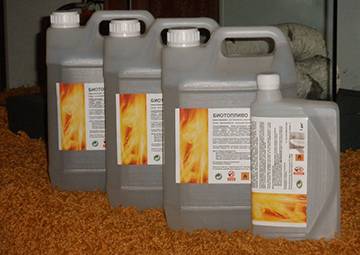 In terms of its main technical characteristics, biofuels used in special biofireplaces are very different from those liquids that are used in classic wood-burning heaters.
In terms of its main technical characteristics, biofuels used in special biofireplaces are very different from those liquids that are used in classic wood-burning heaters.
Denatured ethanol is used for the production of fireplace fuel, which is safe for the environment.
Such fuel compares favorably with the formation of very beautiful and even tongues of flame without the release of by-substances, represented by soot, soot, smoke or fumes. As practice shows, the efficiency of high-quality biofuel exceeds 90-95%.
The best proven biofuel produced by manufacturers in Germany, Holland and France. Their products fully comply with all quality standards, are completely safe in operation and allow you to get a high level of room heating with minimal costs.
Depending on the design features of the fireplace device, biogas can be used as fuel, as well as bioethanol and biodiesel liquid obtained in the process of processing vegetable and animal fats.
Biofuel is sold packaged in special containers of different sizes.
Many modern manufacturers of fireplace fuel are poured into containers that have a very convenient scale for the consumption of flammable liquid.
Some domestic and foreign manufacturers specially add sea salt to the fireplace fuel, which creates the crackling effect of stove logs, as well as special additives that guarantee an attractive and absolutely even orange color of the burner flame.
Instructions for making a biofireplace with your own hands
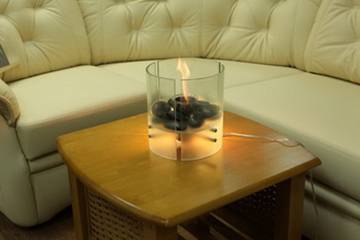 In this section, we will consider how to make a biofireplace with your own hands.
In this section, we will consider how to make a biofireplace with your own hands.
The whole process of self-production of a biofuel tabletop heating fireplace is represented by several stages, including the assembly of the fuel block and glass chamber, as well as the final design and decor of the already completely finished structure:
- At the first stage, it is necessary to build a fuel block based on a ready-made or self-made metal box, which must be painted from the front with high-quality metal paint.
- The inside of the fuel tank must be thoroughly cleaned of dust, rust or welding beads, but it is strictly forbidden to paint it, since otherwise active release of toxic components will be noted during combustion.
- At the next stage, all pre-prepared glass blanks are combined. A high-quality silicone sealant is used for the connection.After the adhesive is applied to the ends, props are applied, which allows you to get the most durable and reliable fastening of the parts.
- As a rule, the sealant layer completely solidifies within a day, after which you need to carefully remove all excess and sagging using a regular blade, clerical or thin pocket knife;
- At the next stage, it is necessary to properly prepare the fireplace biofuel, which, for the sake of safe operation of the heater, must be poured into a metal container and installed in the bottom of the metal fuel block. Be sure to use a lace wick. As necessary, the fuel container is replaced with a new portion of the liquid for burning the tabletop hearth.
At the final stage of manufacturing, it is necessary to make the cover for the heating box yourself. It is best to use a fine-mesh construction metal mesh for this purpose, which should be cut according to the dimensions of the box.
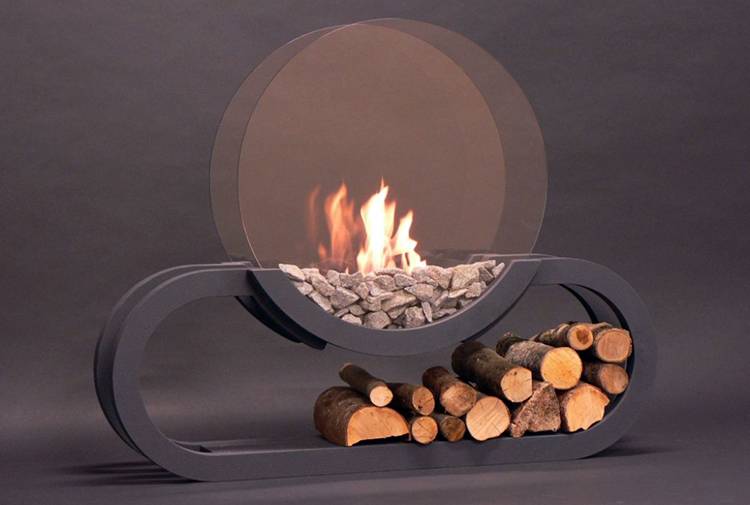
Homemade bio fireplace design
The coarse mesh can be laid in two layers, after which the cover is fixed with thick wire. In this case, the biofuel is topped up by means of a conventional medical syringe.
To give the heating desktop device a finished look and improve the external characteristics, all kinds of decorative elements are used, represented by decorative stones or pebbles.
Laying such natural stones on top of the mesh not only allows for an attractive design, but also helps to achieve the most efficient and even distribution of heat energy.
And if you want a large biofireplace?
With large fireplaces, of course, more hassle. First you need to place the wall and cut from the drywall what you need. If the wall is not made of plaster, then hollow out the millet. Next, you need to make a frame for the fireplace - it can be the same drywall (do not forget to fix the frame).

For the assembly of large fireplaces, however, purchase a specialized fireproof box. Such a miracle is sold in specialty stores. Do not forget that between the frame and the box it is necessary to lay out refractory material, at least mineral wool. And it's better to buy a special, large burner. This option is still cheaper than buying a solid fireplace. We cover with refractory tiles or stone. You can see a photo of a biofireplace on the Internet and how to decorate it.
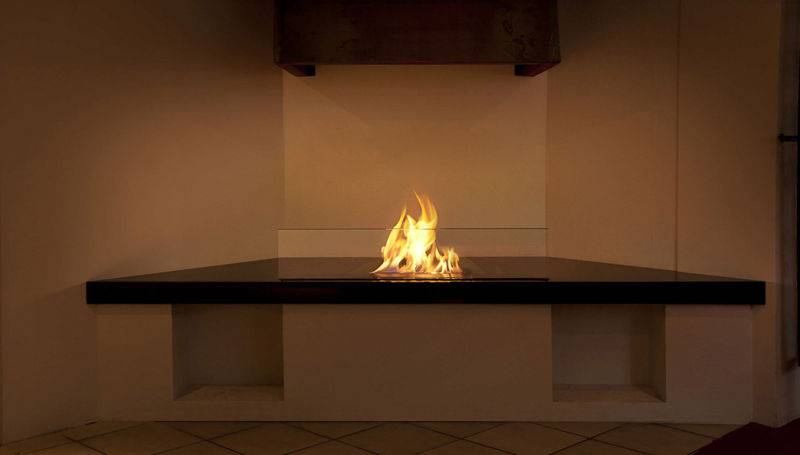
As you can see, it is not so difficult to make a biofireplace with your own hands, the only thing that is now always worth purchasing oil for biofireplaces. The rest of the oils are obviously unhealthy or leave a grime.
How to make a biofireplace with your own hands - step by step instructions
A floor-standing bio-fireplace in its appearance can be indistinguishable from a real one, laid out of bricks and having a chimney. The housing design can be different:
- with columns;
- with protrusions;
- have the shape of a bowl or pedestal with legs.
The base of the biofireplace is easier and cheaper to build from drywall and metal profiles. These materials can be used to make a geometrically correct, semicircular or wavy body. Instead of gypsum board, you can use wood, durable plastic or metal.
Design and drawings
At the design stage, the biofireplace is determined with its dimensions and installation location. Floor structures are stationary, so you need to choose a place so that the fireplace fits harmoniously into the interior after changing the design of the room or purchasing new furniture. For small apartments, medium-sized floor structures indicated in the drawing are suitable.
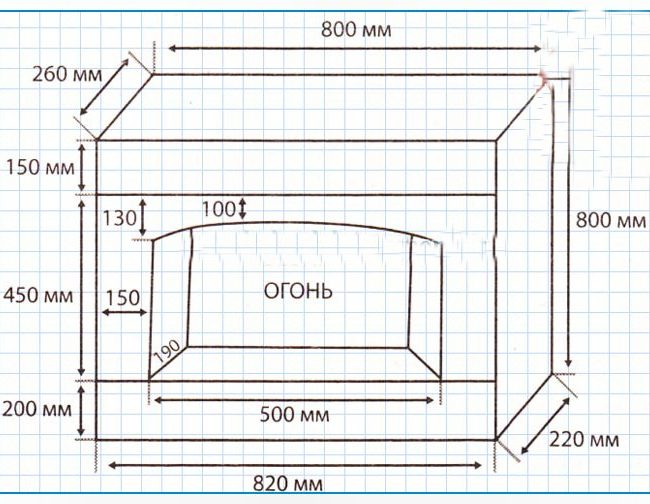
The drawing will help you quickly make all the necessary parts of the fireplace
Manufacturing of the case
To install the biofireplace body you will need:
- drywall 9 mm thick;
- metal profile PP 60/27;
- self-tapping screws;
- screwdriver;
- serpyanka;
- primer;
- putty;
- a spatula with a narrow metal blade;
- roulette;
- ruler;
- bubble level at least 80 cm long;
- pencil or marker.
Suitable for decorating the case:
- fake diamond;
- ceramic tile;
- plastic panels "like a brick" or "like a stone".
Stages of housing installation
-
Wall and floor markings. Based on the previously drawn up drawing, mark the corner points of the back wall of the fireplace on the wall and connect them with straight lines. On the floor, mark the location of the front wall of the cabinet.
-
Installation of the frame. Construct a structure frame from a metal profile. Please note that the planks should not be in close contact with each other. There should be a gap of 2-3 mm between them. This will prevent the structure from skewing during heating and cooling.
-
Frame sheathing. Using a jigsaw or a clerical knife, cut the plasterboard sheets of the required size. Attach them to the metal profile frame. "Drown" the caps of the self-tapping screws into the gypsum board by 1–2 mm.
-
Preparing drywall for finishing. Paste the joints of the gypsum plasterboard sheets with fiberglass mesh tape - serpyanka. Apply putty in the places where the screws are installed and cover with a thin layer of serpyanka. After the putty has dried, start sanding it. To do this, use a special trowel with a sanding mesh.
-
Body cladding. Cover the biofireplace body with the previously selected facing materials.
Installing the fuel block and burner
A metal container for a fuel block can be made with your own hands from stainless steel with a thickness of 2 mm. It is necessary to make a rectangular structure with a bottom and low sides. The dimensions of the unit must match the dimensions of the case.
The burner is a metal cartridge that is installed in a container. Together they form a fuel block. An important element of the burner is the perforated damper, with the help of which the flame is extinguished and its intensity is regulated.
When self-manufacturing, take into account the following:
- the burner must freely enter the metal container;
- the top panel of the burner may be a slotted metal plate;
- the inner cavity of the burner can be filled with mineral wool insulation or medical wool.
The principle of operation of the fuel block:
- ecofuel is poured into a metal container;
- the burner filler absorbs liquid;
- ignite the fuel with a lighter.
Fireplace decoration
A protective screen made of ordinary window glass with polished edges is installed on the front wall of the biofireplace. The fuel block is decorated with ceramic wood or stones.
What it is?
The biofireplace is a bladeless design, where not firewood burns, but liquid fuel. The history of biofireplaces dates back to ancient times, the prototype was oil lamps or special vats with oil.
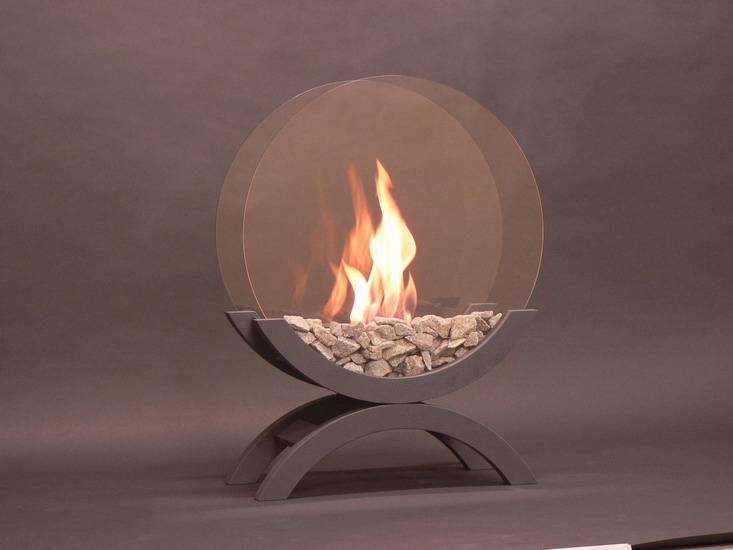
In order to please yourself with a biofireplace, you do not need to build a chimney, but only periodically ventilate the room. After all, this is fire, and it still takes oxygen. Moreover, biofireplaces come in several modifications, which will allow you to make your dreams come true:
- large floor fireplaces, the same size as ordinary ones;
- light fireplaces that effortlessly cling to the wall or ceiling, but only the fireplace will be fenced with special glass for safety reasons.
- small biofireplaces that fit easily on a table or a sideboard and are in perfect harmony with the interior.
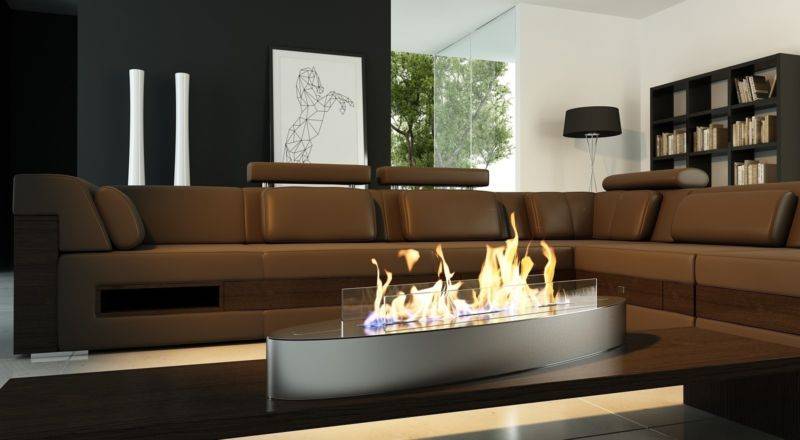
This type of fireplace has a simple design, but is expensive. You can find a way out of the situation and how to make a fireplace with your own hands too, especially since materials for it are sold in every hardware store. To do this, you need the following list:
1. Glass.To do this, you just need to go to a regular glass workshop. Of course, the volume and dimensions will depend on your idea.
2. A silicone sealant that is sold in every hardware store.
3. Metal box or can for flammable liquid. In most cases, there is such a device on the farm.
4. Finishing materials: decorative stone, decorative brick, etc.
5. Wick cord.
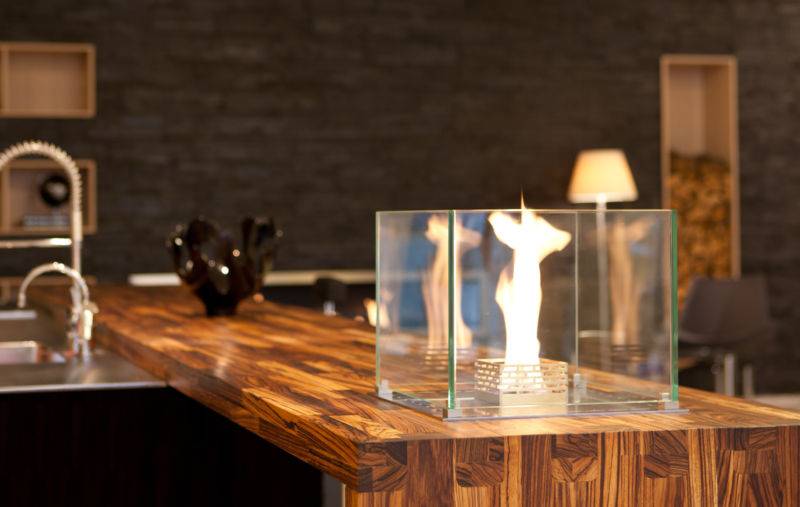
Before you take up a biofireplace, you need to make at least a rough drawing or search on the Internet.

The most important part for a bio fireplace is the burner. If something is done wrong, the consequences can be dire. And so, here are some tips for making:
- if the fireplace is opaque, then you need to paint the narrowness for the fuel from the outside;
- a fine mesh is neatly cut to size and laid out on top of the container. This is necessary for a more even distribution of fire and for decoration. Care must be taken to ensure that this mesh does not fall inside the fuel container.
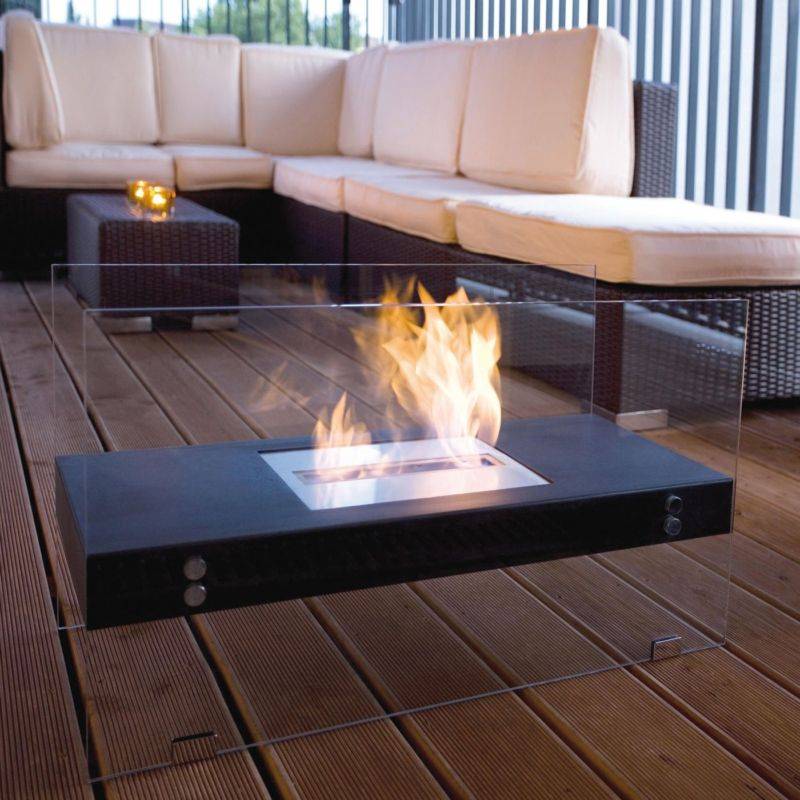
Required materials and tools
The main element of the design is the fuel tank, it is better to make it from a sheet of stainless steel. It can be purchased on the construction market or ordered from craftsmen if you intend to design a large structure.
If there is no need for large volumes, then you can use metal mugs by breaking off their handles. They must be installed in a fireproof tank.
The body itself can be made of almost any transparent material that can withstand high temperatures, for example, smoky special glass. The device can be installed on a coffee table instead of a smoking candle.
If you need an imitation of a real fireplace, you will have to make a decent base, from the following materials:
- Plasterboard sheets;
- Self-tapping screws;
- Metal corners;
- The refractory material used to insulate the structure, it can be, for example, isover.
Simple table biofireplace
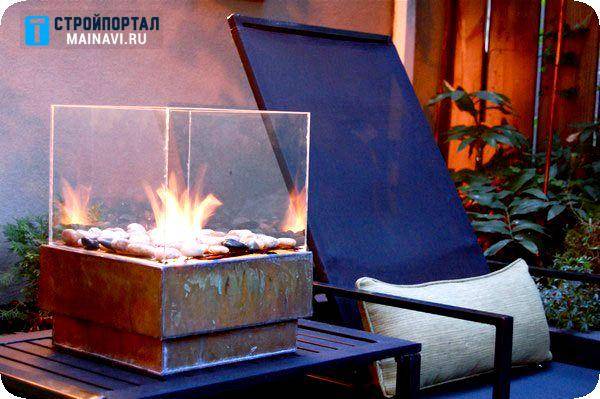
These fireplaces will serve as an ideal addition to any room design, and in the evening will give you the opportunity to admire the living fire in all its glory. One of the main advantages of table fireplaces is their simplicity. Let's take a closer look at how to make one of these biofireplaces.
To create such a fireplace with our own hands, we need:
- 4 glasses.
- Base box made of metal or other refractory material.
- Glass cutter.
- Glass sealant.
- Steel mesh.
- Refractory stones for decoration.
- Fuel tank.
Step-by-step instructions for making a desktop bio fireplace:
- We calculate the dimensions of the future structure. For one burner, the minimum distance between the panes is 15 cm.
- We carry out the adjustment of the glasses to the dimensions of the box. If they fit the size, great. Otherwise, you need to cut off the excess with a glass cutter. After connection, the glass box will be installed on the base.
- We connect the glass with a sealant. To do this, apply a sealant to the end of the glass and connect it at right angles to another glass. It will take at least a day for the sealant to dry completely. For this, stands are installed under each side.
- The glass box without top and bottom is installed on the base. If the calculations were performed correctly, then he should definitely be on the verge. We again use a sealant to hold the glass and base together.
- We put a biofuel burner in the center of the base and cover it with a steel mesh. It must be cut so that its edges lie on the edge of the base. It is recommended to lay the mesh in several layers so that it does not collapse under the weight of decorative stones.
- Lay the stones on the grid in an even layer. If you use natural stones collected by your own hands, they must be rinsed.In this case, when heated, they will not emit an unpleasant odor.
- If necessary, light the burner and check the result.
Important! This design is very easy to assemble, but it has several disadvantages. First of all, it is the impossibility of replenishing fuel without disassembling part of the fireplace
The second disadvantage is the lack of a combustion regulator. As a consequence, neither the flame strength nor the fuel consumption can be changed.
Biofireplace making process
Bio fireplaces may well replace an electric fireplace or a fireplace stove. Such an accessory carries with it a pleasant feeling of warmth and comfort. Of course, there is an option to buy a small potbelly stove, but this is not a very cheap product. The main process for making a home biofuel fireplace will be the selection of the required materials.
- A bio stove is assembled from simple elements: a fuel tank and a frame.
- All work begins with the fact that a diagram of the desired decor item is drawn on paper.
- When it is ready, you can evaluate your capabilities and start purchasing materials. If you find it difficult to develop a product plan, find photos of biofireplaces on the Internet and create your own version based on them.
- Then you should take to the drawing, where you should indicate all the exact dimensions. With its help, you will never get confused and in the end you will get the desired result.
What is biofireplace
The biofireplace, which is coming into fashion, is a decorative source of an open fire that runs on the so-called biofuel. For safe operation, the device is framed by a portal that traps the flame inside itself.
Structurally, a biofireplace is a burner that runs on alcohol fuel. A mandatory element of the device is a fuel tank, which contains a sufficient supply of flammable liquid for operation.
A wick is inserted into the tank, along the fibers of which the fuel rises to the place of combustion. The actual combustion is carried out in a special bowl, which can have a very different shape. The sizes of biofireplaces vary considerably.
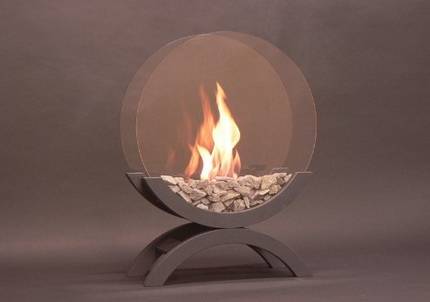
Installing a bio fireplace is a great way to decorate the interior, make it unusual and attractive. Depending on the type of device and model, the fire can be completely open or closed from several sides by the portal walls, transparent and opaque
In addition, some burners are equipped with nozzles. This makes the tongues of flame as similar as possible to those that are formed when burning wood in a fire or fireplace.
The devices are very easy to use. First of all, they don't need a chimney. During combustion, biofuels are oxidized to carbon dioxide and water vapor. The absence of heavy impurities in the flammable liquid allows it to burn completely, without the formation of soot, soot and volatile toxic substances.
Therefore, smoke evacuation (and it is not formed) is not required. Thanks to this, the biofireplace can be installed anywhere in the room.
He does not need a heat-resistant floor strap or a separate foundation. Special permission for its installation is also not required. The only thing that needs to be considered when choosing a place for installing a bio fireplace is the possibility of airing the room or the presence of effective ventilation. This is necessary because oxygen is used during combustion, the amount of which must be constantly replenished.
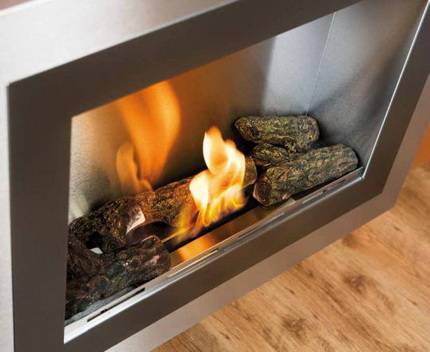
So that the biofireplace does not differ from the real one, it can be decorated with firewood made of refractory ceramics. They are released in the form of whole or semi-burnt logs.
Bio fireplaces are not only decorative, but also functional. Unlike traditional fireplaces, where most of the heat "goes" into the chimney, the devices completely give their heat to the room. Of course, using such a device as a heating device will not work, but it will be able to heat some area in the room. Bio fireplaces are completely safe provided they are properly used.
The industry produces the most comfortable models to use, equipped with electronic control. They can be controlled from the remote control or via Wi-Fi. In the latter case, it is quite possible to integrate the device into the “Smart Home” system, remotely control it from a phone or tablet. It is clear that the cost of automatic biofireplaces is an order of magnitude higher than that of conventional ones.
At the same time, standard models can be considered "eternal", since they are structurally extremely simple and there is nothing to break in them, while devices stuffed with electronics may well fail.
Disadvantages of biofireplace
Along with its advantages, this product has its own disadvantages, which are a tribute to convenience, safety and environmental friendliness.
Dependence on one type of fuel. The burner works only on alcohols, while a regular fireplace can be fired with any solid combustible substance.
The relative high cost of fuel. A medium-sized heating block (burner) consumes 0.3–0.4 liters per hour. The average cost of 1 liter of fuel is 200–250 rubles *. Burning a fireplace for one hour will cost about 100 rubles.
We are talking about factory fuel for biofireplaces.
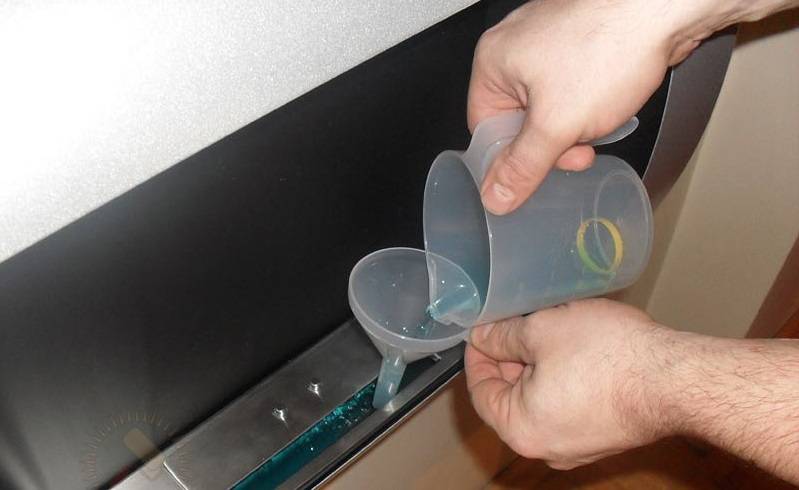
The minimum area of the room. The room in which the hearth is installed must be at least 25 sq. m.
| Name | Dimensions, mm | Specifications | price, rub. |
| Floor standing | |||
| DirectCheminee Universal, France / Russia | 760x335x800 | 1 TB * 2.5 L, hearth walls included, classic look | 75 000 |
| DirectCheminee Universal X2, France / Russia | 980х345х1100 | 2 TB x 2.5 L, hearth walls included, classic view | 95 000 |
| Planika CALVADOS Cherry / Ivory, Poland | 860x870x365 | 1 TB 2.8 L, wood portal, classic look | 120 000 |
| DirectCheminee Baroque Italiano, France / Russia | 1300x400x1100 | 1TB 3L, portal and cast marble top, exquisite look | 145 000 |
| BERLONI Turin, Italy | 1100x1100x320 | 2 TB 2.2 L each, MDF portal and painted steel | 58 000 |
| Horus Freedom Wall, Italy | 950x400x870 | 1 TB 2.9 L, steel and glass portal | 160 000 |
| Horus Tetris, Italy | 1000x1000x450 | 1 TB, stainless steel and painted steel, tempered glass, independent arrangement | 177 000 |
| Wall mounted | |||
| Planika Wallfire, Poland | 360х810х210 | thermostat, fan heater, stainless steel / glass, 2.5-3.7 kW | 191 000 |
| Horus ZEN, Italy | 1200x340x450 | steel / glass, 2.1-2.8 kW | 140 000 |
| Horus Closer inox Frame, Italy | 640x640x220 | steel / glass, 1.8-2.2 kW | 110 000 |
| DirectCheminee Premier, France / Russia | 800x250x500 | Any finish from any material, 1.8–2.6 kW | 42 000 |
| DirectCheminee Autofire 146 electronic, France / Russia | 1460x290x620 | Fully electronic control system, flow rate 1 l / h, 6.2 kW | 300 000 |
| DirectCheminee Monumentale Huge for 5 furnaces, France / Russia | 2000x300x790 | 5 TB painted steel 5.8 kW | 220 000 |
| Desktop (small) | |||
| DirectCheminee Bio candle Reed 3, France / Russia | — | Interior element, stainless steel steel | 16 000 |
| DirectCheminee Bio candle "Classic" on marble base (Modern collection), France / Russia | — | Interior element, stainless steel steel, marble | 9 000 |
| DirectCheminee Block-box 2.5 l (Artificial stone), France / Russia | 440x340x105 | St. steel, artificial stone of your choice (200 types) | 28 000 |
| DirectCheminee Block box INOX 5 l, France / Russia | 550х510х350 | St. steel, surface finish - mirror, metal, wood | 50 000 |
| Planika Simple Commerce, Poland | height 420, diameter 380 | Glass flask - Italy, burner - 1.5 L (7 hours) | 48 500 |
| Planika Stone, Poland | height 410, diameter 450 | Glass flask - Italy, at the base of the Scandinavian field stone, burner - 0.6 l (up to 2 hours) | 82 000 |
| Planika VERANDA GF-07 Table, Poland | height 597, diameter 700 | Glass - Italy, wood legs - teak, burner 1 l (3.5 hours) | 95 000 |
* TB - fuel block.
Advantages of the bio fireplace
Bio-fireplace is a new product on the market that is rapidly gaining popularity. This is not only a tribute to fashion, but also a lot of beneficial benefits.
Convenience. The cleanliness of combustion emissions allows the use of a biofireplace without a chimney. This decisive advantage makes it an extremely technological product - the fireplace can be placed anywhere that suits the installation requirements. It does not require a separate foundation and heat-resistant floor strapping. Approximately 50% of these products are made in a portable version, the rest are mounted on the floor, walls and even suspended from the ceiling.

Manufacturability. The Alcohol Burner Hearth can be purchased separately, without a portal. It can then be installed in an existing traditional fireplace insert. This will preserve the function and appearance of the interior and eliminate the need to procure solid fuel and the risk of smoke. Full-fledged biofireplaces, due to their simplicity and low cost of construction, are made in a sufficient range of sizes.The portal can also be made to order from any material.
Security. Factory fireplaces are supplied complete with protective panels and covers, so the portal of the biofireplace can be made of drywall or wood without fear of overheating ignition. Ignition and combustion of fuel occurs without sparks and flame fluctuations (when using a special lighter). When burned, the fuel decomposes into water vapor and CO2. The concentration of carbon dioxide is negligible and does not affect the air quality in the presence of standard room ventilation.
Functionality. In a conventional fireplace, most of the heat is removed along with toxic exhaust gases through the chimney. In a biofireplace, the entire combustion temperature is transferred to the ambient air. A medium sized device is equivalent to a 3 kW electric heater.
Reliability, simplicity of the device. Basic models of alcohol fireplaces do not have mechanisms, moving parts, abrasive parts. If used correctly, these are "eternal" devices (service life is unlimited). "Bioburning" does not form carbon deposits, which reduces the maintenance of the fireplace to wiping along with other elements of the interior. More complex and expensive models have electronic control - from the panel, remote control or Wi-Fi from a tablet or phone. Like any electronic device, they can fail, but not more often than others.
Originality and beauty. The new biofireplace can be matched to absolutely any design - from minimalist cold high-tech to luxurious baroque. The portal can be ordered in any workshop, from any material. Such a hearth of open fire in the middle of the room will become the emotional center of the whole house, intuitively reminding of the rest of distant ancestors at night by the fire. Always even and stable tongues of flame are a "living" piece of interior that can be moved at your discretion.
Price. The price of the device itself together with the portal does not exceed the price of a fireplace of the same format with a traditional or electrical layout.
DIY biofireplace from drywall
The chosen place determines the shape along which the biofireplace will be made - angular or straight, along the wall. Anyone who sets out to create a hearth at home should prepare or find a sketch with instructions on how to make a biofireplace yourself, and purchase the necessary materials:
- Drywall and profiles for it.
- Self-tapping screws.
- Interior materials such as ceramic tiles and heat-resistant adhesive.
- Exterior material such as stone.
- Cotton wool, grout and finishing putty.
We advise you to read in more detail on our website how to make a desktop biofireplace yourself.
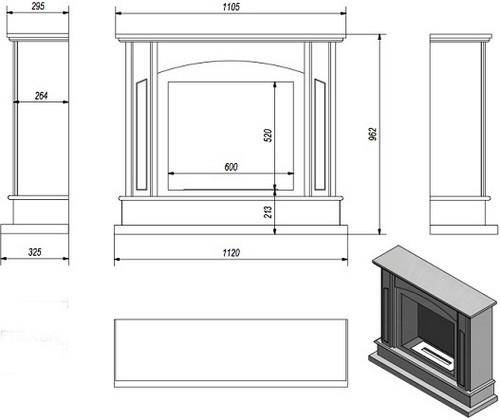
Drawings of finished biofireplaces contain information on how to make biofireplaces, namely, to determine the size. However, the design of the structure can be absolutely anything - you just need to use your imagination.
When everything is ready to get started, you can proceed with the sequential execution of the following steps:
According to the instructions, marking lines are outlined on the wall, to which the formed guides for the biofireplace body are subsequently attached. With the help of self-tapping screws, rack profiles and a frame are placed.
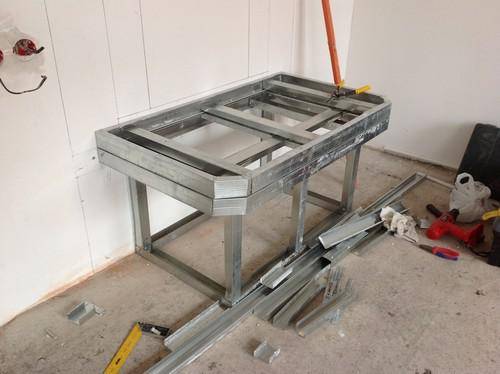
Using a plumb line, you need to check the correct location of all elements
Further, during the construction of a biofireplace, the frame is sheathed with plasterboard. The optimal distance at which it should be fastened is from 10 to 15 cm.When performing this work, it is also necessary to lay a layer of mineral wool about 5 cm thick in the area of the firebox.

The direction of the fibers - vertical or chaotic - of mineral wool affects the properties that it best provides.So, for biofireplaces, a material with a chaotic direction is suitable, which better provides thermal insulation properties.
A recess is left at the bottom of the furnace, into which the burner will be installed in the future. Then, with the help of non-combustible materials, the bottom of the biofireplace is made out. From the outside, the drywall is putty and revetted with the selected material.
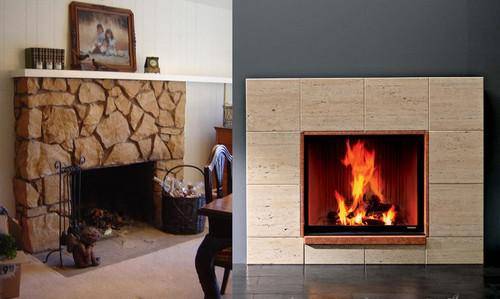
For cladding, a material that is more suitable for the interior and price parameter is selected. The main thing is that it is fireproof.
The remaining seams are rubbed, the surface is wiped with a damp and dry cloth. After that, when building a biofireplace with your own hands, you can start decorating - add a burner, lay out decorative elements. You can also take additional protective measures, such as installing fireproof glass on the front wall.

The burner allows you to reproduce fire evenly, in bright color, without flares. Some burner models contain protection against fuel spillage during overturning.
Step by step assembly instructions in detail
There are a lot of ways to make a fireplace for apartments. For example, there are step-by-step instructions for assembling a decorative stove that will fit perfectly into any home.
To create it, you need the following details:
- a fuel block with a valve, a support for it (made of metal);
- fire-resistant ceramic glass for both walls;
- bolts, washers and soft washers;
- rubber pads and metal legs;
- black paint that protects against fire, or a special material used for panel design (stone, aluminum).

Regular assembly:
First of all, make a part for the tank.
- According to the blueprints, make 2 beams. They will play the role of fastening the plywood part. You only need to cut the top and bottom halves. A glass frame will be attached at the bottom.
- At the top, make a rectangular hole for the fuel container.
- Drill holes for the bolts. Bolts that have silicone gaskets will pass through them. All actions must be carried out carefully so that the structure does not break.
- When the structure is ready, a fuel tank is installed in its upper half (in the cut hole).
Types of biofireplaces
Depending on the dimensions of the structure and the place of its installation, there are several types of biofireplaces.

There are several types of bio fireplaces
Floor standing
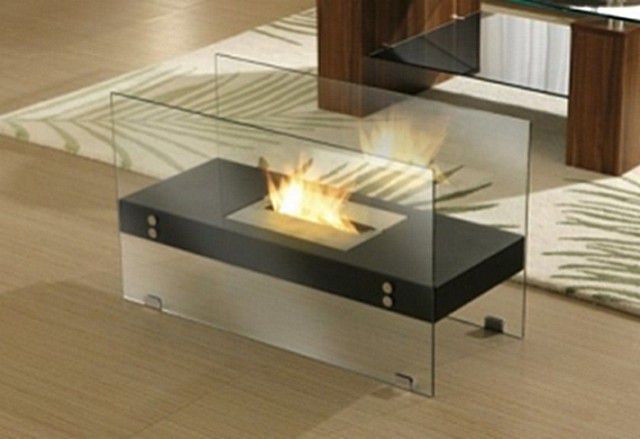
The advantages of such a fireplace are its mobility.
Solid and solid structures that can be installed next to a wall or anywhere in the room. The design solution of the case is very different. There are eco-fireplaces made in the form of a tree trunk, forged, decorated with carved metal canvases, decorated with colored glass inserts.
Ceramic firewood, which looks almost indistinguishable from real ones, are bought for outdoor devices. Imitations of coniferous and deciduous trees are possible. These accessories bring the appearance of the bio fireplace as close as possible to the natural one. The burner is decorated with chipped or rounded stones. They are necessary to create the effect of a more "live", natural flame.
Wall (mounted)

Hinged biofireplace can be placed at any height
Wall-mounted biofireplaces are lightweight and lightweight devices equipped with protective fire-resistant and transparent screens on 1, 2 or 3 sides. All models are flat, equipped with a back panel made of heat-resistant material. The advantages of this type of biofireplace include:
- a light weight;
- the ability to install at any height;
- modern style solution.
To exclude the possibility of falling, the hinged devices are securely fixed to the walls.
Tabletop

A tabletop fireplace will become a stylish piece of furniture
Table biofireplaces are miniature spectacular products that can decorate any interior. Most often they consist of a metal body filled with small stones. They are equipped with transparent glasses along the perimeter or on both sides. The main advantage of these models is their low fuel consumption. Miniature eco-fireplaces will decorate the festive table, create a calm and peaceful atmosphere.
Embedded
Built-in bio fireplaces are produced in the form of metal modules with a front protective screen.
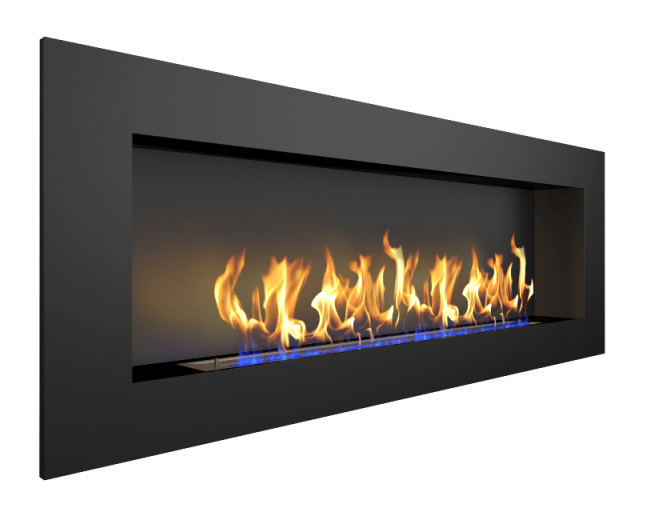
Bio fireplaces of this type can be built into walls or special niches
Installed in niches built of brick, concrete or drywall. There are models designed to be built into furniture. The fuel block and burner are decorated with ceramic wood or stones.
Built-in eco fireplaces have their own advantages:
- allow you to save space and are the best choice for small apartments;
- provide a modern interior design;
- equipped with a height-adjustable screen.
Conclusions and useful video on the topic
We make a miniature desktop biofireplace:
Automatic biofireplace - what is it:
Biofireplace manufacturing process:
Bio fireplace will give your home a special atmosphere. To enjoy the dance of living fire at any time, it is enough to assemble a simple structure.
It is important not to forget about the safety rules: do not use fuel of unknown origin, do not leave the fire unattended, do not pour fuel into an uncooled device and do not forget to regularly ventilate the room in which the biofireplace is operating. Have you completed the interior with your own biofireplace? Do you have any extras or helpful building tips? Or have you noticed inaccuracies in the material we have proposed? Write to us about it, share photos of your homemade products - your experience will inspire the creativity of other users
Have you completed the interior with your own biofireplace? Do you have any additions or helpful building tips? Or have you noticed inaccuracies in the material we have proposed? Write to us about it, share photos of your homemade products - your experience will inspire the creativity of other users.
